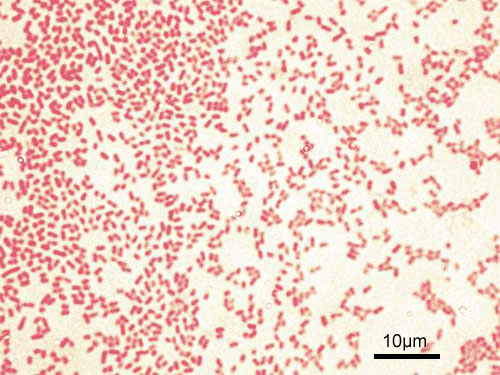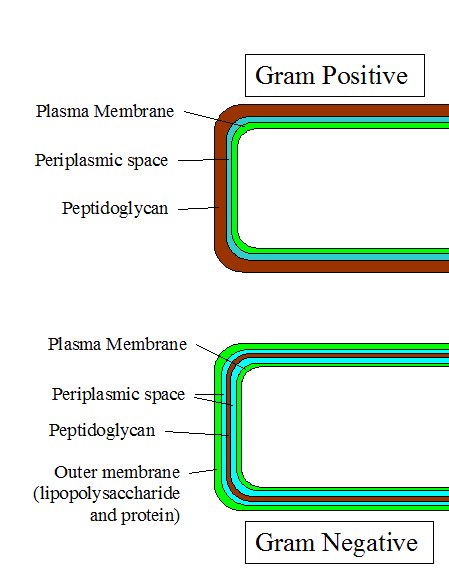Gram-negative bacteria
Editor-In-Chief: C. Michael Gibson, M.S., M.D. [1]
 |
 |
Overview
Gram-negative bacteria are those bacteria that do not retain crystal violet dye in the Gram staining protocol.[1] Gram-positive bacteria will retain the crystal violet dye when washed in a decolorizing solution. In a Gram stain test, a counterstain (commonly safranin) is added after the crystal violet, coloring all Gram-negative bacteria a red or pink color. The test itself is useful in classifying two distinct types of bacteria based on structural differences in their cell walls.
Many species of Gram-negative bacteria are pathogenic, meaning they can cause disease in a host organism. This pathogenic capability is usually associated with certain components of Gram-negative cell walls, in particular the lipopolysaccharide (also known as LPS or endotoxin) layer.[1] In humans, LPS triggers an innate immune response characterized by cytokine production and immune system activation. Inflammation is a common result of cytokine production, which can also produce host toxicity.
Characteristics
The following characteristics are displayed by Gram-negative bacteria:
- Cytoplasmic membrane
- Thin peptidoglycan layer (which is present in much higher levels in Gram-positive bacteria)
- Outer membrane containing lipopolysaccharide (LPS, which consists of lipid A, core polysaccharide, and O antigen) outside the peptidoglycan layer
- Porins exist in the outer membrane, which act like pores for particular molecules
- There is a space between the layers of peptidoglycan and the secondary cell membrane called the periplasmic space
- The S-layer is directly attached to the outer membrane, rather than the peptidoglycan
- If present, flagella have four supporting rings instead of two
- No teichoic acids or lipoteichoic acids are present
- Lipoproteins are attached to the polysaccharide backbone whereas in Gram-positive bacteria no lipoproteins are present
- Most do not sporulate (Coxiella burnetti, which produces spore-like structures, is a notable exception)
Example species
The proteobacteria are a major group of Gram-negative bacteria, including Escherichia coli, Salmonella, and other Enterobacteriaceae, Pseudomonas, Moraxella, Helicobacter, Stenotrophomonas, Bdellovibrio, acetic acid bacteria, Legionella and alpha-proteobacteria as Wolbachia and many others. Other notable groups of Gram-negative bacteria include the cyanobacteria, spirochaetes, green sulfur and green non-sulfur bacteria. Crenarchaeota: Unique because most bacteria have gram-positive molecules in their capsules, it has gram-negative.
Medically relevant Gram-negative cocci include three organisms, which cause a sexually transmitted disease (Neisseria gonorrhoeae), a meningitis (Neisseria meningitidis), and respiratory symptoms (Moraxella catarrhalis).
Medically relevant Gram-negative bacilli include a multitude of species. Some of them primarily cause respiratory problems (Hemophilus influenzae, Klebsiella pneumoniae, Legionella pneumophila, Pseudomonas aeruginosa), primarily urinary problems (Escherichia coli, Proteus mirabilis, Enterobacter cloacae, Serratia marcescens), and primarily gastrointestinal problems (Helicobacter pylori, Salmonella enteritidis, Salmonella typhi).
Gram negative bacteria associated with nosocomial infections include Acinetobacter baumanii, which cause bacteremia, secondary meningitis, and ventilator-associated pneumonia in intensive care units of hospital establishments.
Medical treatment
One of the several unique characteristics of Gram-negative bacteria is the outer membrane. This outer membrane is responsible for protecting the bacteria from several antibiotics, dyes, and detergents which would normally damage the inner membrane or cell wall (peptidoglycan). The outer membrane provides these bacteria with resistance to lysozyme and penicillin. Fortunately, alternative medicinal treatments such as lysozyme with EDTA, and the antibiotic ampicillin have been developed to combat the protective outer membrane of some pathogenic Gram-negative organisms. Other drugs can be used, namely chloramphenicol, streptomycin, and nalidixic acid.
See also
References
- ↑ Jump up to: 1.0 1.1 Salton MJR, Kim KS (1996). Structure. in: Baron's Medical Microbiology (Baron S et al, eds.) (4th ed. ed.). Univ of Texas Medical Branch. ISBN 0-9631172-1-1.